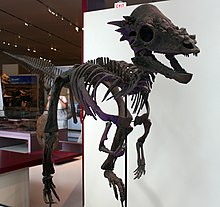Our website is made possible by displaying online advertisements to our visitors.
Please consider supporting us by disabling your ad blocker.
Pachycephalosaurus
| Pachycephalosaurus Temporal range: Late Cretaceous (Maastrichtian),
| |
|---|---|

| |
| Cast of the "Sandy" specimen, Royal Ontario Museum | |
| Scientific classification | |
| Domain: | Eukaryota |
| Kingdom: | Animalia |
| Phylum: | Chordata |
| Clade: | Dinosauria |
| Clade: | †Ornithischia |
| Clade: | †Pachycephalosauria |
| Family: | †Pachycephalosauridae |
| Tribe: | †Pachycephalosaurini |
| Genus: | †Pachycephalosaurus Brown & Schlaikjer, 1943 |
| Type species | |
| †Pachycephalosaurus grangeri Brown & Schlaikjer, 1943
(Junior synonym of P. wyomingensis) | |
| Species | |
| |
| Synonyms | |
|
Synonyms of P. wyomingensis
| |
Pachycephalosaurus (/ˌpækɪˌsɛfələˈsɔːrəs/;[2] meaning "thick-headed lizard", from Greek pachys-/παχύς- "thickness", kephalon/κεφαλή "head" and sauros/σαῦρος "lizard")[3] is a genus of pachycephalosaurid ornithischian dinosaur. The type species, P. wyomingensis, is the only known definitive species. The possibly synonymous taxon, Stygimoloch, might represent a distinct genus or a second species, P. spinifer. It lived during the Maastrichtian age of the Late Cretaceous period in what is now western North America. Remains have been excavated in Montana, South Dakota, Wyoming, and Alberta. Mainly known from a single skull and a few extremely thick skull roofs (at 22 cm or 9 in thick), Pachycephalosaurus is estimated to have reached 4.5 m (15 ft) long and weighed 370–450 kg (820–990 lb). More complete fossils would come to be found in the following years.
Pachycephalosaurus was among the last species of non-avian dinosaurs on Earth before the Cretaceous–Paleogene extinction event. The genus Tylosteus has been synonymized with Pachycephalosaurus, as have the genera Stygimoloch and Dracorex, in recent studies.[4][5]
Like other pachycephalosaurids, Pachycephalosaurus was a bipedal herbivore, possessing long, strong legs and somewhat small arms with five-fingered hands. Pachycephalosaurus is the largest-known pachycephalosaur, known for having an extremely thick, slightly domed skull roof; visually, the structure of the skull suggests a ‘battering ram' function in life, evolved for use as a defensive mechanism or intra-species combat, similar to what is seen with today's bighorn sheep or muskoxen (with male animals routinely charging and head-butting each other for dominance). This hypothesis has actually been highly disputed in recent years.
- ^ Giffin, Emily B.; Gabriel, Diane L.; Johnson, Rolf E. (January 22, 1988). "A New Pachycephalosaurid Hell Creek Formation of Montana". Journal of Vertebrate Paleontology. 7 (4). Taylor & Francis, Ltd.: 398–407. doi:10.1080/02724634.1988.10011672. JSTOR 4523163. Retrieved November 13, 2020.
- ^ "Definition of pachycephalosaurus | Dictionary.com". www.dictionary.com. Retrieved February 22, 2020.
- ^ Colbert, Edwin H. (Edwin Harris); Knight, Charles Robert (1951). The dinosaur book: the ruling reptiles and their relatives. New York: McGraw-Hill. p. 152.
- ^ Cite error: The named reference
HG09was invoked but never defined (see the help page). - ^ Goodwin, Mark B.; Evans, David C. (2016). "The early expression of squamosal horns and parietal ornamentation confirmed by new end-stage juvenile Pachycephalosaurus fossils from the Upper Cretaceous Hell Creek Formation, Montana". Journal of Vertebrate Paleontology. 36 (2): e1078343. Bibcode:2016JVPal..36E8343G. doi:10.1080/02724634.2016.1078343. ISSN 0272-4634. S2CID 131282984.
Previous Page Next Page


